The Role of Equality and Diversity in the Workplace: A Research Report
VerifiedAdded on 2023/01/19
|11
|2878
|48
Report
AI Summary
This research report delves into the critical aspects of equality and diversity within the workplace, using TESCO as a case study. The report begins with an introduction that outlines the research aim, objectives, questions, and the rationale behind the investigation, highlighting the significance of equality and diversity in fostering a better organizational culture. A comprehensive literature review explores the concepts of equality and diversity, emphasizing their benefits, such as increased productivity and improved employee engagement. The review also addresses the challenges faced by companies like TESCO in promoting equality and diversity, including issues related to acceptance, communication, and cultural differences. Furthermore, the report identifies various strategies for developing an effective organizational culture, such as regular training, mentorship programs, and inclusive workforce policies. The methodology section details the qualitative research approach, including the use of descriptive research design and data collection methods such as questionnaires. The report also includes a timeline for the research activities and concludes with references.
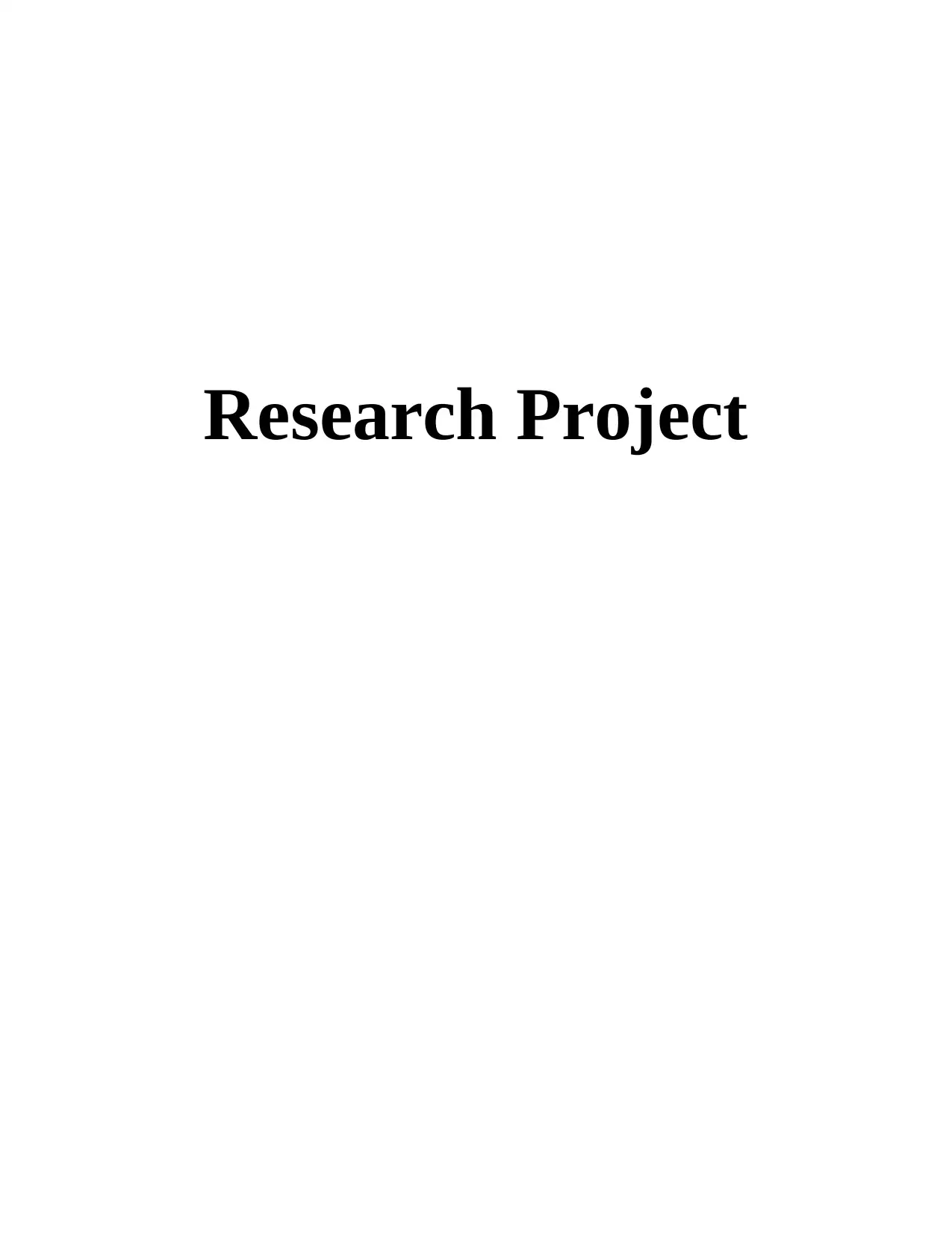
Research Project
Paraphrase This Document
Need a fresh take? Get an instant paraphrase of this document with our AI Paraphraser
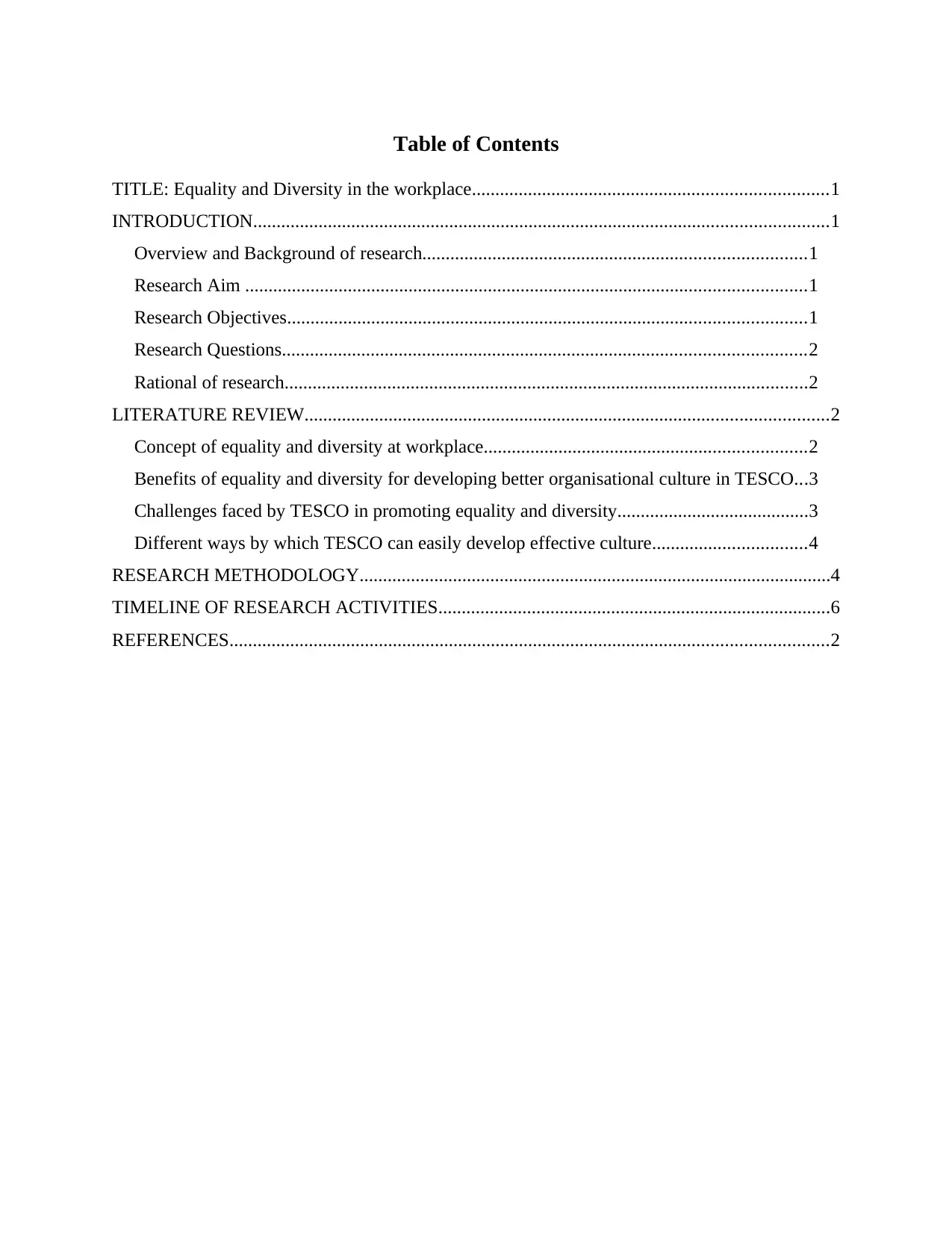
Table of Contents
TITLE: Equality and Diversity in the workplace............................................................................1
INTRODUCTION...........................................................................................................................1
Overview and Background of research..................................................................................1
Research Aim ........................................................................................................................1
Research Objectives...............................................................................................................1
Research Questions................................................................................................................2
Rational of research................................................................................................................2
LITERATURE REVIEW................................................................................................................2
Concept of equality and diversity at workplace.....................................................................2
Benefits of equality and diversity for developing better organisational culture in TESCO...3
Challenges faced by TESCO in promoting equality and diversity.........................................3
Different ways by which TESCO can easily develop effective culture.................................4
RESEARCH METHODOLOGY.....................................................................................................4
TIMELINE OF RESEARCH ACTIVITIES....................................................................................6
REFERENCES................................................................................................................................2
TITLE: Equality and Diversity in the workplace............................................................................1
INTRODUCTION...........................................................................................................................1
Overview and Background of research..................................................................................1
Research Aim ........................................................................................................................1
Research Objectives...............................................................................................................1
Research Questions................................................................................................................2
Rational of research................................................................................................................2
LITERATURE REVIEW................................................................................................................2
Concept of equality and diversity at workplace.....................................................................2
Benefits of equality and diversity for developing better organisational culture in TESCO...3
Challenges faced by TESCO in promoting equality and diversity.........................................3
Different ways by which TESCO can easily develop effective culture.................................4
RESEARCH METHODOLOGY.....................................................................................................4
TIMELINE OF RESEARCH ACTIVITIES....................................................................................6
REFERENCES................................................................................................................................2
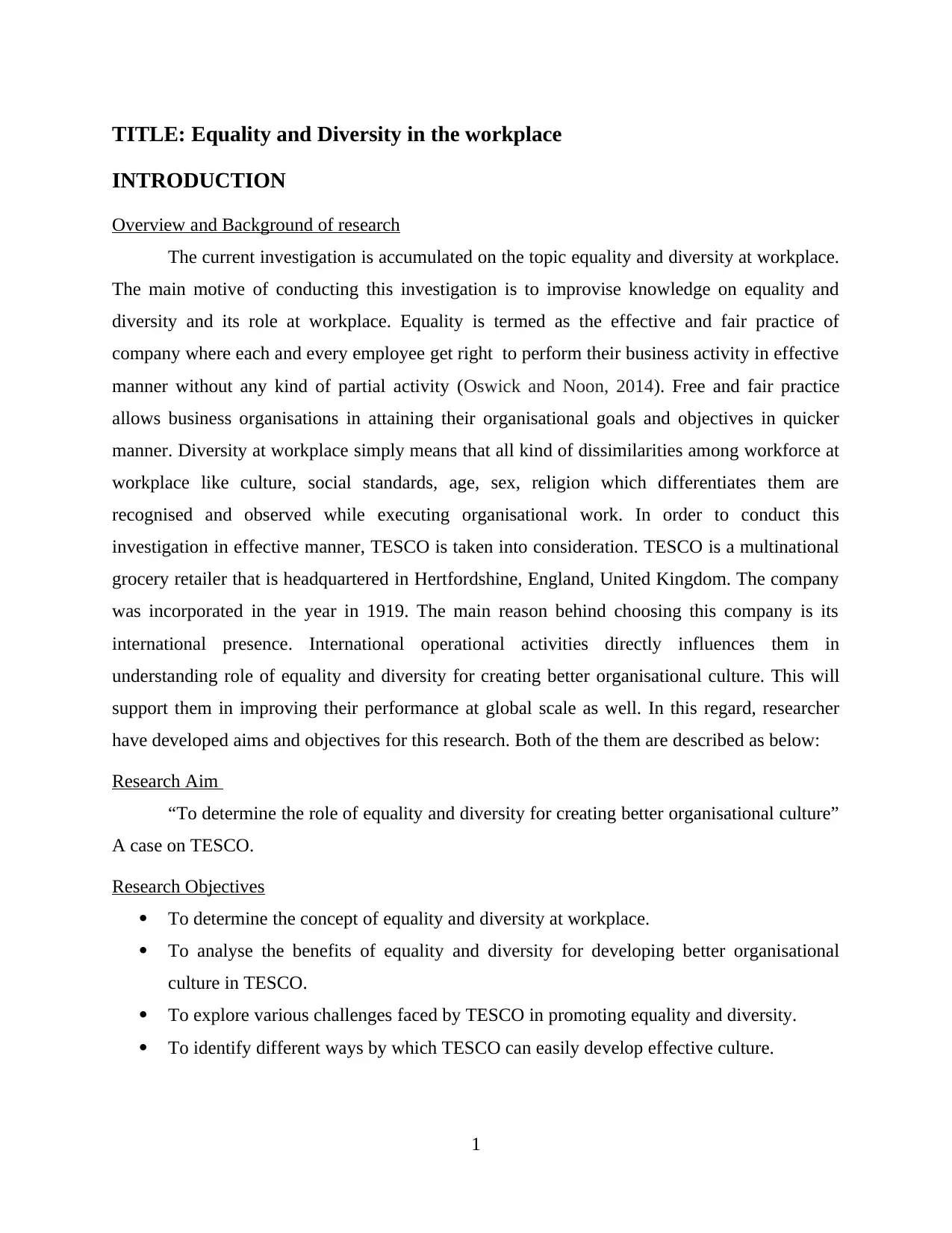
TITLE: Equality and Diversity in the workplace
INTRODUCTION
Overview and Background of research
The current investigation is accumulated on the topic equality and diversity at workplace.
The main motive of conducting this investigation is to improvise knowledge on equality and
diversity and its role at workplace. Equality is termed as the effective and fair practice of
company where each and every employee get right to perform their business activity in effective
manner without any kind of partial activity (Oswick and Noon, 2014). Free and fair practice
allows business organisations in attaining their organisational goals and objectives in quicker
manner. Diversity at workplace simply means that all kind of dissimilarities among workforce at
workplace like culture, social standards, age, sex, religion which differentiates them are
recognised and observed while executing organisational work. In order to conduct this
investigation in effective manner, TESCO is taken into consideration. TESCO is a multinational
grocery retailer that is headquartered in Hertfordshine, England, United Kingdom. The company
was incorporated in the year in 1919. The main reason behind choosing this company is its
international presence. International operational activities directly influences them in
understanding role of equality and diversity for creating better organisational culture. This will
support them in improving their performance at global scale as well. In this regard, researcher
have developed aims and objectives for this research. Both of the them are described as below:
Research Aim
“To determine the role of equality and diversity for creating better organisational culture”
A case on TESCO.
Research Objectives
To determine the concept of equality and diversity at workplace.
To analyse the benefits of equality and diversity for developing better organisational
culture in TESCO.
To explore various challenges faced by TESCO in promoting equality and diversity.
To identify different ways by which TESCO can easily develop effective culture.
1
INTRODUCTION
Overview and Background of research
The current investigation is accumulated on the topic equality and diversity at workplace.
The main motive of conducting this investigation is to improvise knowledge on equality and
diversity and its role at workplace. Equality is termed as the effective and fair practice of
company where each and every employee get right to perform their business activity in effective
manner without any kind of partial activity (Oswick and Noon, 2014). Free and fair practice
allows business organisations in attaining their organisational goals and objectives in quicker
manner. Diversity at workplace simply means that all kind of dissimilarities among workforce at
workplace like culture, social standards, age, sex, religion which differentiates them are
recognised and observed while executing organisational work. In order to conduct this
investigation in effective manner, TESCO is taken into consideration. TESCO is a multinational
grocery retailer that is headquartered in Hertfordshine, England, United Kingdom. The company
was incorporated in the year in 1919. The main reason behind choosing this company is its
international presence. International operational activities directly influences them in
understanding role of equality and diversity for creating better organisational culture. This will
support them in improving their performance at global scale as well. In this regard, researcher
have developed aims and objectives for this research. Both of the them are described as below:
Research Aim
“To determine the role of equality and diversity for creating better organisational culture”
A case on TESCO.
Research Objectives
To determine the concept of equality and diversity at workplace.
To analyse the benefits of equality and diversity for developing better organisational
culture in TESCO.
To explore various challenges faced by TESCO in promoting equality and diversity.
To identify different ways by which TESCO can easily develop effective culture.
1
⊘ This is a preview!⊘
Do you want full access?
Subscribe today to unlock all pages.

Trusted by 1+ million students worldwide
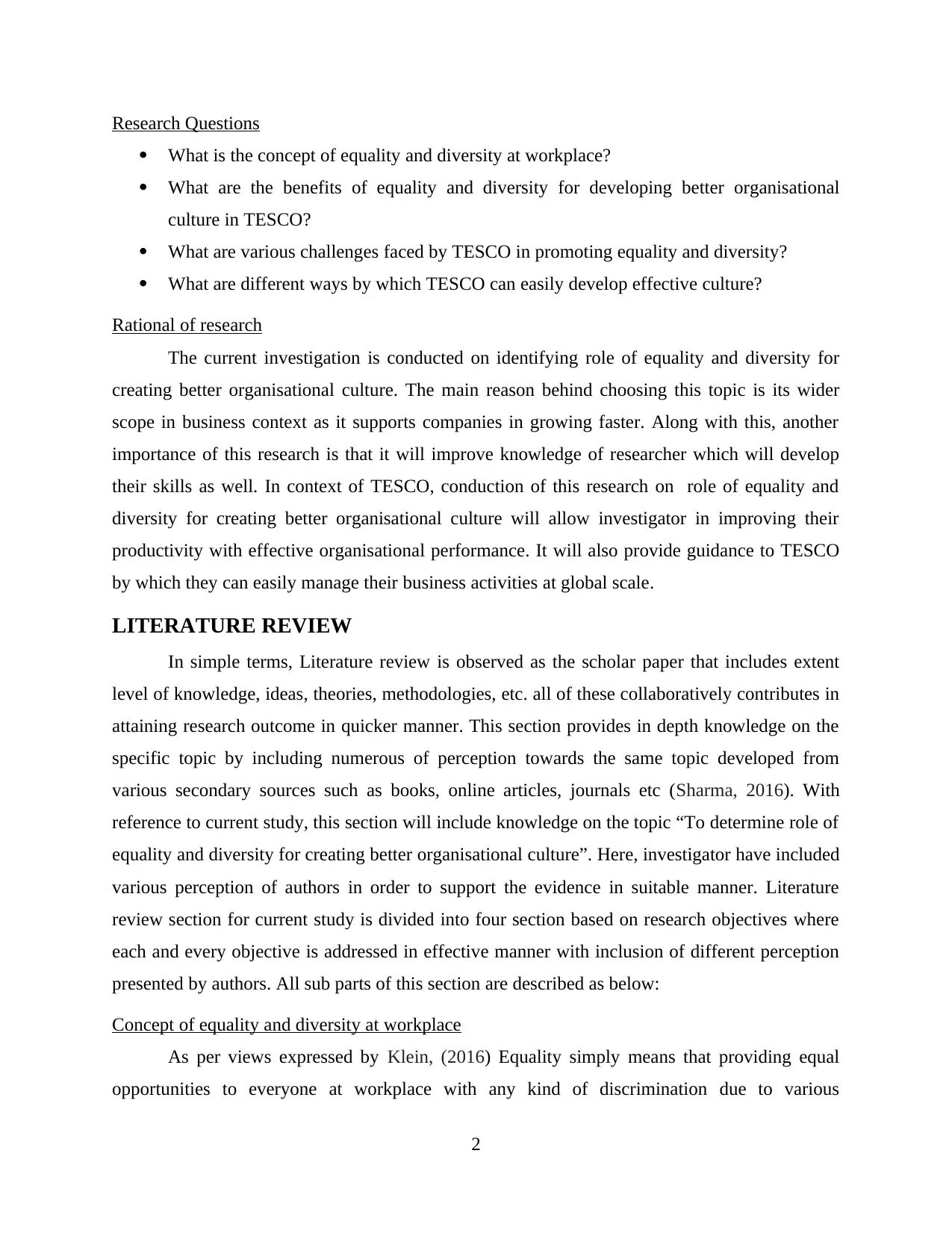
Research Questions
What is the concept of equality and diversity at workplace?
What are the benefits of equality and diversity for developing better organisational
culture in TESCO?
What are various challenges faced by TESCO in promoting equality and diversity?
What are different ways by which TESCO can easily develop effective culture?
Rational of research
The current investigation is conducted on identifying role of equality and diversity for
creating better organisational culture. The main reason behind choosing this topic is its wider
scope in business context as it supports companies in growing faster. Along with this, another
importance of this research is that it will improve knowledge of researcher which will develop
their skills as well. In context of TESCO, conduction of this research on role of equality and
diversity for creating better organisational culture will allow investigator in improving their
productivity with effective organisational performance. It will also provide guidance to TESCO
by which they can easily manage their business activities at global scale.
LITERATURE REVIEW
In simple terms, Literature review is observed as the scholar paper that includes extent
level of knowledge, ideas, theories, methodologies, etc. all of these collaboratively contributes in
attaining research outcome in quicker manner. This section provides in depth knowledge on the
specific topic by including numerous of perception towards the same topic developed from
various secondary sources such as books, online articles, journals etc (Sharma, 2016). With
reference to current study, this section will include knowledge on the topic “To determine role of
equality and diversity for creating better organisational culture”. Here, investigator have included
various perception of authors in order to support the evidence in suitable manner. Literature
review section for current study is divided into four section based on research objectives where
each and every objective is addressed in effective manner with inclusion of different perception
presented by authors. All sub parts of this section are described as below:
Concept of equality and diversity at workplace
As per views expressed by Klein, (2016) Equality simply means that providing equal
opportunities to everyone at workplace with any kind of discrimination due to various
2
What is the concept of equality and diversity at workplace?
What are the benefits of equality and diversity for developing better organisational
culture in TESCO?
What are various challenges faced by TESCO in promoting equality and diversity?
What are different ways by which TESCO can easily develop effective culture?
Rational of research
The current investigation is conducted on identifying role of equality and diversity for
creating better organisational culture. The main reason behind choosing this topic is its wider
scope in business context as it supports companies in growing faster. Along with this, another
importance of this research is that it will improve knowledge of researcher which will develop
their skills as well. In context of TESCO, conduction of this research on role of equality and
diversity for creating better organisational culture will allow investigator in improving their
productivity with effective organisational performance. It will also provide guidance to TESCO
by which they can easily manage their business activities at global scale.
LITERATURE REVIEW
In simple terms, Literature review is observed as the scholar paper that includes extent
level of knowledge, ideas, theories, methodologies, etc. all of these collaboratively contributes in
attaining research outcome in quicker manner. This section provides in depth knowledge on the
specific topic by including numerous of perception towards the same topic developed from
various secondary sources such as books, online articles, journals etc (Sharma, 2016). With
reference to current study, this section will include knowledge on the topic “To determine role of
equality and diversity for creating better organisational culture”. Here, investigator have included
various perception of authors in order to support the evidence in suitable manner. Literature
review section for current study is divided into four section based on research objectives where
each and every objective is addressed in effective manner with inclusion of different perception
presented by authors. All sub parts of this section are described as below:
Concept of equality and diversity at workplace
As per views expressed by Klein, (2016) Equality simply means that providing equal
opportunities to everyone at workplace with any kind of discrimination due to various
2
Paraphrase This Document
Need a fresh take? Get an instant paraphrase of this document with our AI Paraphraser
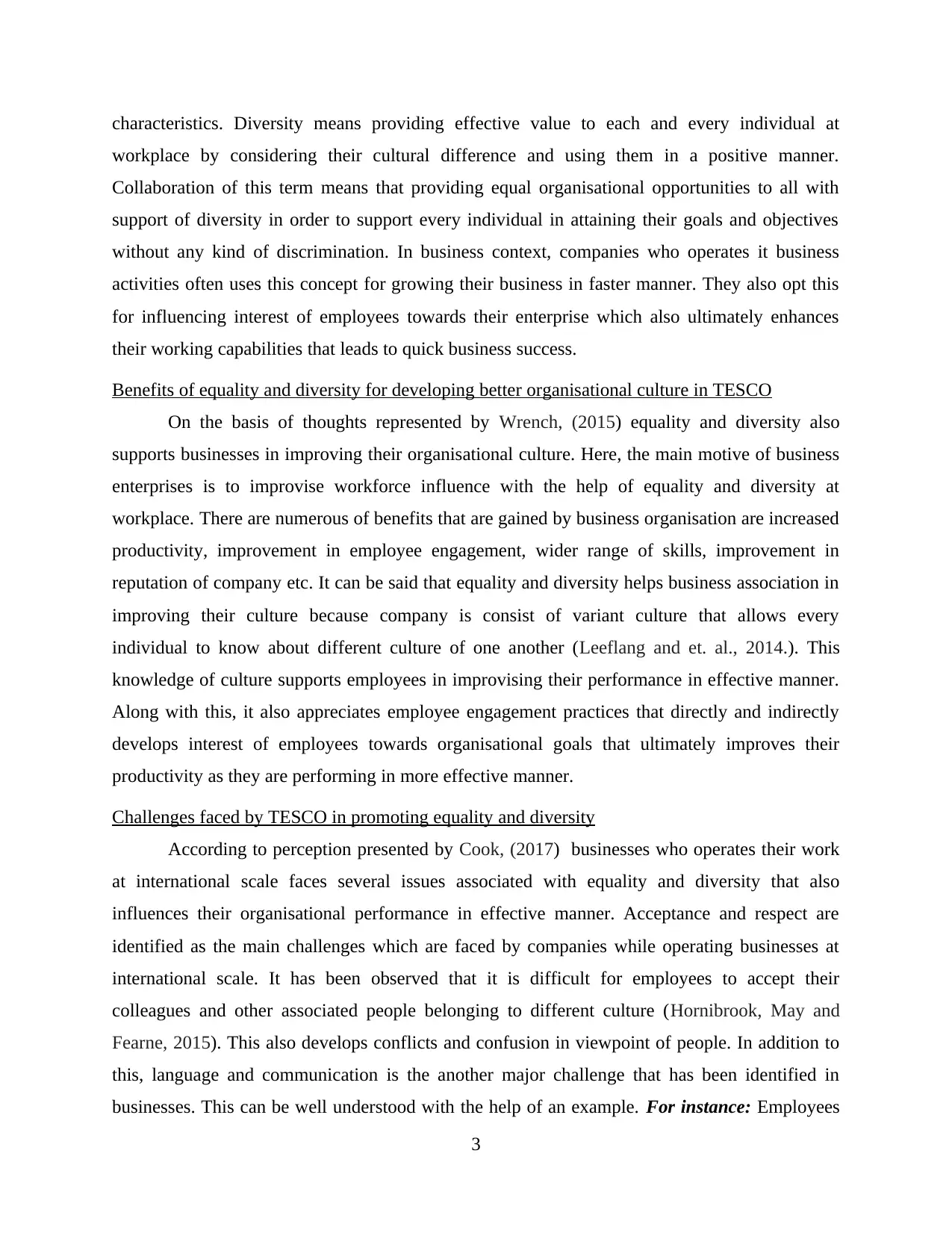
characteristics. Diversity means providing effective value to each and every individual at
workplace by considering their cultural difference and using them in a positive manner.
Collaboration of this term means that providing equal organisational opportunities to all with
support of diversity in order to support every individual in attaining their goals and objectives
without any kind of discrimination. In business context, companies who operates it business
activities often uses this concept for growing their business in faster manner. They also opt this
for influencing interest of employees towards their enterprise which also ultimately enhances
their working capabilities that leads to quick business success.
Benefits of equality and diversity for developing better organisational culture in TESCO
On the basis of thoughts represented by Wrench, (2015) equality and diversity also
supports businesses in improving their organisational culture. Here, the main motive of business
enterprises is to improvise workforce influence with the help of equality and diversity at
workplace. There are numerous of benefits that are gained by business organisation are increased
productivity, improvement in employee engagement, wider range of skills, improvement in
reputation of company etc. It can be said that equality and diversity helps business association in
improving their culture because company is consist of variant culture that allows every
individual to know about different culture of one another (Leeflang and et. al., 2014.). This
knowledge of culture supports employees in improvising their performance in effective manner.
Along with this, it also appreciates employee engagement practices that directly and indirectly
develops interest of employees towards organisational goals that ultimately improves their
productivity as they are performing in more effective manner.
Challenges faced by TESCO in promoting equality and diversity
According to perception presented by Cook, (2017) businesses who operates their work
at international scale faces several issues associated with equality and diversity that also
influences their organisational performance in effective manner. Acceptance and respect are
identified as the main challenges which are faced by companies while operating businesses at
international scale. It has been observed that it is difficult for employees to accept their
colleagues and other associated people belonging to different culture (Hornibrook, May and
Fearne, 2015). This also develops conflicts and confusion in viewpoint of people. In addition to
this, language and communication is the another major challenge that has been identified in
businesses. This can be well understood with the help of an example. For instance: Employees
3
workplace by considering their cultural difference and using them in a positive manner.
Collaboration of this term means that providing equal organisational opportunities to all with
support of diversity in order to support every individual in attaining their goals and objectives
without any kind of discrimination. In business context, companies who operates it business
activities often uses this concept for growing their business in faster manner. They also opt this
for influencing interest of employees towards their enterprise which also ultimately enhances
their working capabilities that leads to quick business success.
Benefits of equality and diversity for developing better organisational culture in TESCO
On the basis of thoughts represented by Wrench, (2015) equality and diversity also
supports businesses in improving their organisational culture. Here, the main motive of business
enterprises is to improvise workforce influence with the help of equality and diversity at
workplace. There are numerous of benefits that are gained by business organisation are increased
productivity, improvement in employee engagement, wider range of skills, improvement in
reputation of company etc. It can be said that equality and diversity helps business association in
improving their culture because company is consist of variant culture that allows every
individual to know about different culture of one another (Leeflang and et. al., 2014.). This
knowledge of culture supports employees in improvising their performance in effective manner.
Along with this, it also appreciates employee engagement practices that directly and indirectly
develops interest of employees towards organisational goals that ultimately improves their
productivity as they are performing in more effective manner.
Challenges faced by TESCO in promoting equality and diversity
According to perception presented by Cook, (2017) businesses who operates their work
at international scale faces several issues associated with equality and diversity that also
influences their organisational performance in effective manner. Acceptance and respect are
identified as the main challenges which are faced by companies while operating businesses at
international scale. It has been observed that it is difficult for employees to accept their
colleagues and other associated people belonging to different culture (Hornibrook, May and
Fearne, 2015). This also develops conflicts and confusion in viewpoint of people. In addition to
this, language and communication is the another major challenge that has been identified in
businesses. This can be well understood with the help of an example. For instance: Employees
3
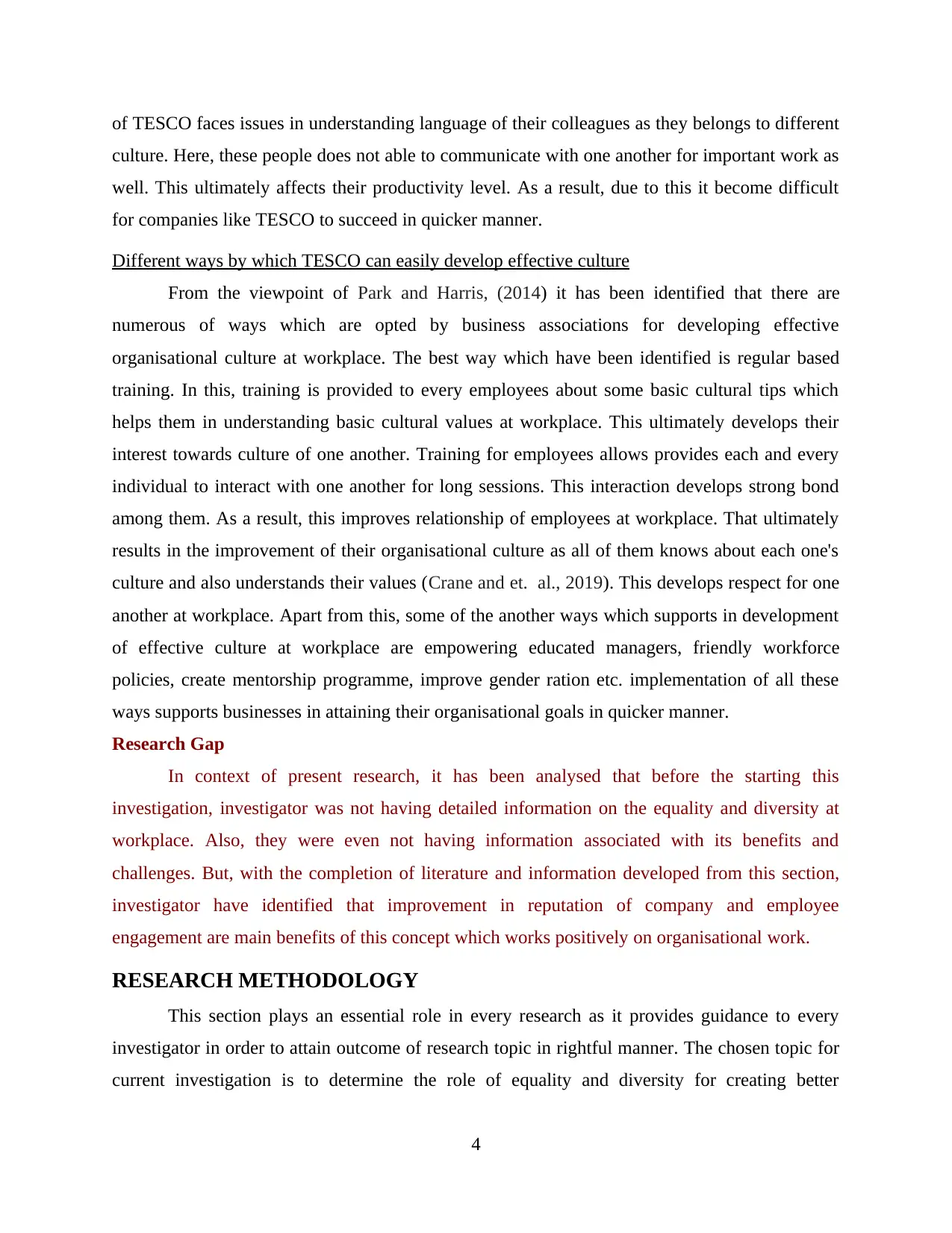
of TESCO faces issues in understanding language of their colleagues as they belongs to different
culture. Here, these people does not able to communicate with one another for important work as
well. This ultimately affects their productivity level. As a result, due to this it become difficult
for companies like TESCO to succeed in quicker manner.
Different ways by which TESCO can easily develop effective culture
From the viewpoint of Park and Harris, (2014) it has been identified that there are
numerous of ways which are opted by business associations for developing effective
organisational culture at workplace. The best way which have been identified is regular based
training. In this, training is provided to every employees about some basic cultural tips which
helps them in understanding basic cultural values at workplace. This ultimately develops their
interest towards culture of one another. Training for employees allows provides each and every
individual to interact with one another for long sessions. This interaction develops strong bond
among them. As a result, this improves relationship of employees at workplace. That ultimately
results in the improvement of their organisational culture as all of them knows about each one's
culture and also understands their values (Crane and et. al., 2019). This develops respect for one
another at workplace. Apart from this, some of the another ways which supports in development
of effective culture at workplace are empowering educated managers, friendly workforce
policies, create mentorship programme, improve gender ration etc. implementation of all these
ways supports businesses in attaining their organisational goals in quicker manner.
Research Gap
In context of present research, it has been analysed that before the starting this
investigation, investigator was not having detailed information on the equality and diversity at
workplace. Also, they were even not having information associated with its benefits and
challenges. But, with the completion of literature and information developed from this section,
investigator have identified that improvement in reputation of company and employee
engagement are main benefits of this concept which works positively on organisational work.
RESEARCH METHODOLOGY
This section plays an essential role in every research as it provides guidance to every
investigator in order to attain outcome of research topic in rightful manner. The chosen topic for
current investigation is to determine the role of equality and diversity for creating better
4
culture. Here, these people does not able to communicate with one another for important work as
well. This ultimately affects their productivity level. As a result, due to this it become difficult
for companies like TESCO to succeed in quicker manner.
Different ways by which TESCO can easily develop effective culture
From the viewpoint of Park and Harris, (2014) it has been identified that there are
numerous of ways which are opted by business associations for developing effective
organisational culture at workplace. The best way which have been identified is regular based
training. In this, training is provided to every employees about some basic cultural tips which
helps them in understanding basic cultural values at workplace. This ultimately develops their
interest towards culture of one another. Training for employees allows provides each and every
individual to interact with one another for long sessions. This interaction develops strong bond
among them. As a result, this improves relationship of employees at workplace. That ultimately
results in the improvement of their organisational culture as all of them knows about each one's
culture and also understands their values (Crane and et. al., 2019). This develops respect for one
another at workplace. Apart from this, some of the another ways which supports in development
of effective culture at workplace are empowering educated managers, friendly workforce
policies, create mentorship programme, improve gender ration etc. implementation of all these
ways supports businesses in attaining their organisational goals in quicker manner.
Research Gap
In context of present research, it has been analysed that before the starting this
investigation, investigator was not having detailed information on the equality and diversity at
workplace. Also, they were even not having information associated with its benefits and
challenges. But, with the completion of literature and information developed from this section,
investigator have identified that improvement in reputation of company and employee
engagement are main benefits of this concept which works positively on organisational work.
RESEARCH METHODOLOGY
This section plays an essential role in every research as it provides guidance to every
investigator in order to attain outcome of research topic in rightful manner. The chosen topic for
current investigation is to determine the role of equality and diversity for creating better
4
⊘ This is a preview!⊘
Do you want full access?
Subscribe today to unlock all pages.

Trusted by 1+ million students worldwide
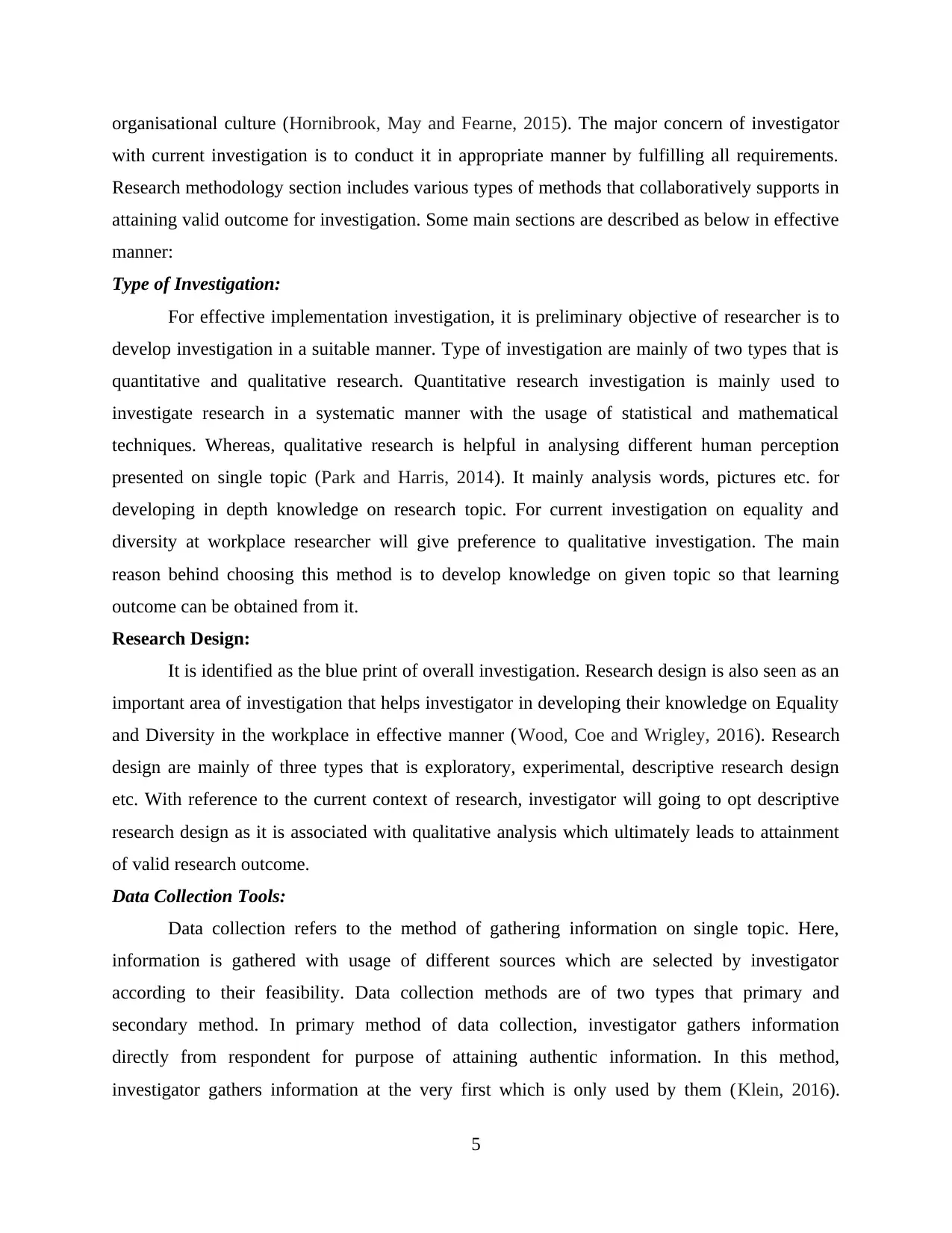
organisational culture (Hornibrook, May and Fearne, 2015). The major concern of investigator
with current investigation is to conduct it in appropriate manner by fulfilling all requirements.
Research methodology section includes various types of methods that collaboratively supports in
attaining valid outcome for investigation. Some main sections are described as below in effective
manner:
Type of Investigation:
For effective implementation investigation, it is preliminary objective of researcher is to
develop investigation in a suitable manner. Type of investigation are mainly of two types that is
quantitative and qualitative research. Quantitative research investigation is mainly used to
investigate research in a systematic manner with the usage of statistical and mathematical
techniques. Whereas, qualitative research is helpful in analysing different human perception
presented on single topic (Park and Harris, 2014). It mainly analysis words, pictures etc. for
developing in depth knowledge on research topic. For current investigation on equality and
diversity at workplace researcher will give preference to qualitative investigation. The main
reason behind choosing this method is to develop knowledge on given topic so that learning
outcome can be obtained from it.
Research Design:
It is identified as the blue print of overall investigation. Research design is also seen as an
important area of investigation that helps investigator in developing their knowledge on Equality
and Diversity in the workplace in effective manner (Wood, Coe and Wrigley, 2016). Research
design are mainly of three types that is exploratory, experimental, descriptive research design
etc. With reference to the current context of research, investigator will going to opt descriptive
research design as it is associated with qualitative analysis which ultimately leads to attainment
of valid research outcome.
Data Collection Tools:
Data collection refers to the method of gathering information on single topic. Here,
information is gathered with usage of different sources which are selected by investigator
according to their feasibility. Data collection methods are of two types that primary and
secondary method. In primary method of data collection, investigator gathers information
directly from respondent for purpose of attaining authentic information. In this method,
investigator gathers information at the very first which is only used by them (Klein, 2016).
5
with current investigation is to conduct it in appropriate manner by fulfilling all requirements.
Research methodology section includes various types of methods that collaboratively supports in
attaining valid outcome for investigation. Some main sections are described as below in effective
manner:
Type of Investigation:
For effective implementation investigation, it is preliminary objective of researcher is to
develop investigation in a suitable manner. Type of investigation are mainly of two types that is
quantitative and qualitative research. Quantitative research investigation is mainly used to
investigate research in a systematic manner with the usage of statistical and mathematical
techniques. Whereas, qualitative research is helpful in analysing different human perception
presented on single topic (Park and Harris, 2014). It mainly analysis words, pictures etc. for
developing in depth knowledge on research topic. For current investigation on equality and
diversity at workplace researcher will give preference to qualitative investigation. The main
reason behind choosing this method is to develop knowledge on given topic so that learning
outcome can be obtained from it.
Research Design:
It is identified as the blue print of overall investigation. Research design is also seen as an
important area of investigation that helps investigator in developing their knowledge on Equality
and Diversity in the workplace in effective manner (Wood, Coe and Wrigley, 2016). Research
design are mainly of three types that is exploratory, experimental, descriptive research design
etc. With reference to the current context of research, investigator will going to opt descriptive
research design as it is associated with qualitative analysis which ultimately leads to attainment
of valid research outcome.
Data Collection Tools:
Data collection refers to the method of gathering information on single topic. Here,
information is gathered with usage of different sources which are selected by investigator
according to their feasibility. Data collection methods are of two types that primary and
secondary method. In primary method of data collection, investigator gathers information
directly from respondent for purpose of attaining authentic information. In this method,
investigator gathers information at the very first which is only used by them (Klein, 2016).
5
Paraphrase This Document
Need a fresh take? Get an instant paraphrase of this document with our AI Paraphraser
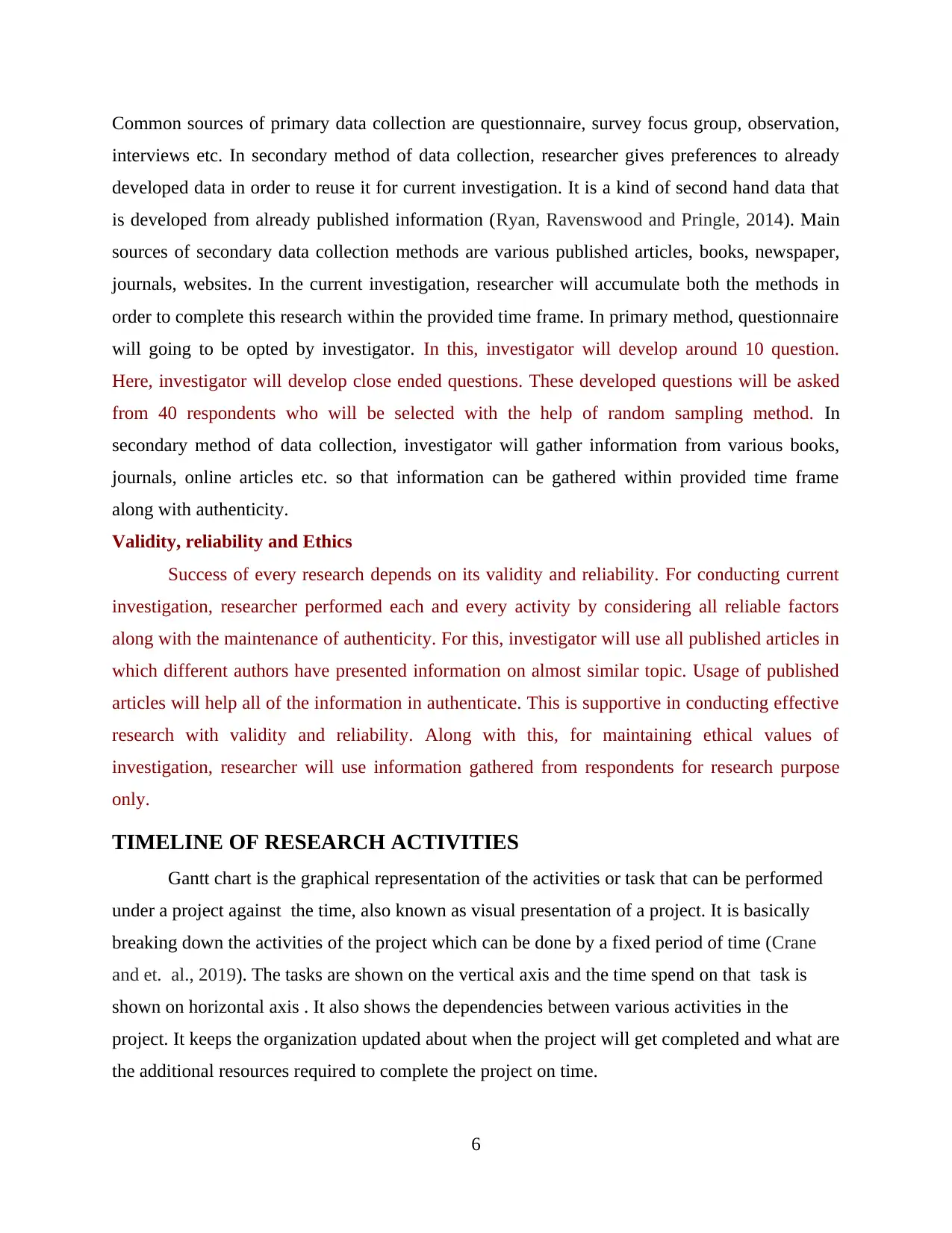
Common sources of primary data collection are questionnaire, survey focus group, observation,
interviews etc. In secondary method of data collection, researcher gives preferences to already
developed data in order to reuse it for current investigation. It is a kind of second hand data that
is developed from already published information (Ryan, Ravenswood and Pringle, 2014). Main
sources of secondary data collection methods are various published articles, books, newspaper,
journals, websites. In the current investigation, researcher will accumulate both the methods in
order to complete this research within the provided time frame. In primary method, questionnaire
will going to be opted by investigator. In this, investigator will develop around 10 question.
Here, investigator will develop close ended questions. These developed questions will be asked
from 40 respondents who will be selected with the help of random sampling method. In
secondary method of data collection, investigator will gather information from various books,
journals, online articles etc. so that information can be gathered within provided time frame
along with authenticity.
Validity, reliability and Ethics
Success of every research depends on its validity and reliability. For conducting current
investigation, researcher performed each and every activity by considering all reliable factors
along with the maintenance of authenticity. For this, investigator will use all published articles in
which different authors have presented information on almost similar topic. Usage of published
articles will help all of the information in authenticate. This is supportive in conducting effective
research with validity and reliability. Along with this, for maintaining ethical values of
investigation, researcher will use information gathered from respondents for research purpose
only.
TIMELINE OF RESEARCH ACTIVITIES
Gantt chart is the graphical representation of the activities or task that can be performed
under a project against the time, also known as visual presentation of a project. It is basically
breaking down the activities of the project which can be done by a fixed period of time (Crane
and et. al., 2019). The tasks are shown on the vertical axis and the time spend on that task is
shown on horizontal axis . It also shows the dependencies between various activities in the
project. It keeps the organization updated about when the project will get completed and what are
the additional resources required to complete the project on time.
6
interviews etc. In secondary method of data collection, researcher gives preferences to already
developed data in order to reuse it for current investigation. It is a kind of second hand data that
is developed from already published information (Ryan, Ravenswood and Pringle, 2014). Main
sources of secondary data collection methods are various published articles, books, newspaper,
journals, websites. In the current investigation, researcher will accumulate both the methods in
order to complete this research within the provided time frame. In primary method, questionnaire
will going to be opted by investigator. In this, investigator will develop around 10 question.
Here, investigator will develop close ended questions. These developed questions will be asked
from 40 respondents who will be selected with the help of random sampling method. In
secondary method of data collection, investigator will gather information from various books,
journals, online articles etc. so that information can be gathered within provided time frame
along with authenticity.
Validity, reliability and Ethics
Success of every research depends on its validity and reliability. For conducting current
investigation, researcher performed each and every activity by considering all reliable factors
along with the maintenance of authenticity. For this, investigator will use all published articles in
which different authors have presented information on almost similar topic. Usage of published
articles will help all of the information in authenticate. This is supportive in conducting effective
research with validity and reliability. Along with this, for maintaining ethical values of
investigation, researcher will use information gathered from respondents for research purpose
only.
TIMELINE OF RESEARCH ACTIVITIES
Gantt chart is the graphical representation of the activities or task that can be performed
under a project against the time, also known as visual presentation of a project. It is basically
breaking down the activities of the project which can be done by a fixed period of time (Crane
and et. al., 2019). The tasks are shown on the vertical axis and the time spend on that task is
shown on horizontal axis . It also shows the dependencies between various activities in the
project. It keeps the organization updated about when the project will get completed and what are
the additional resources required to complete the project on time.
6
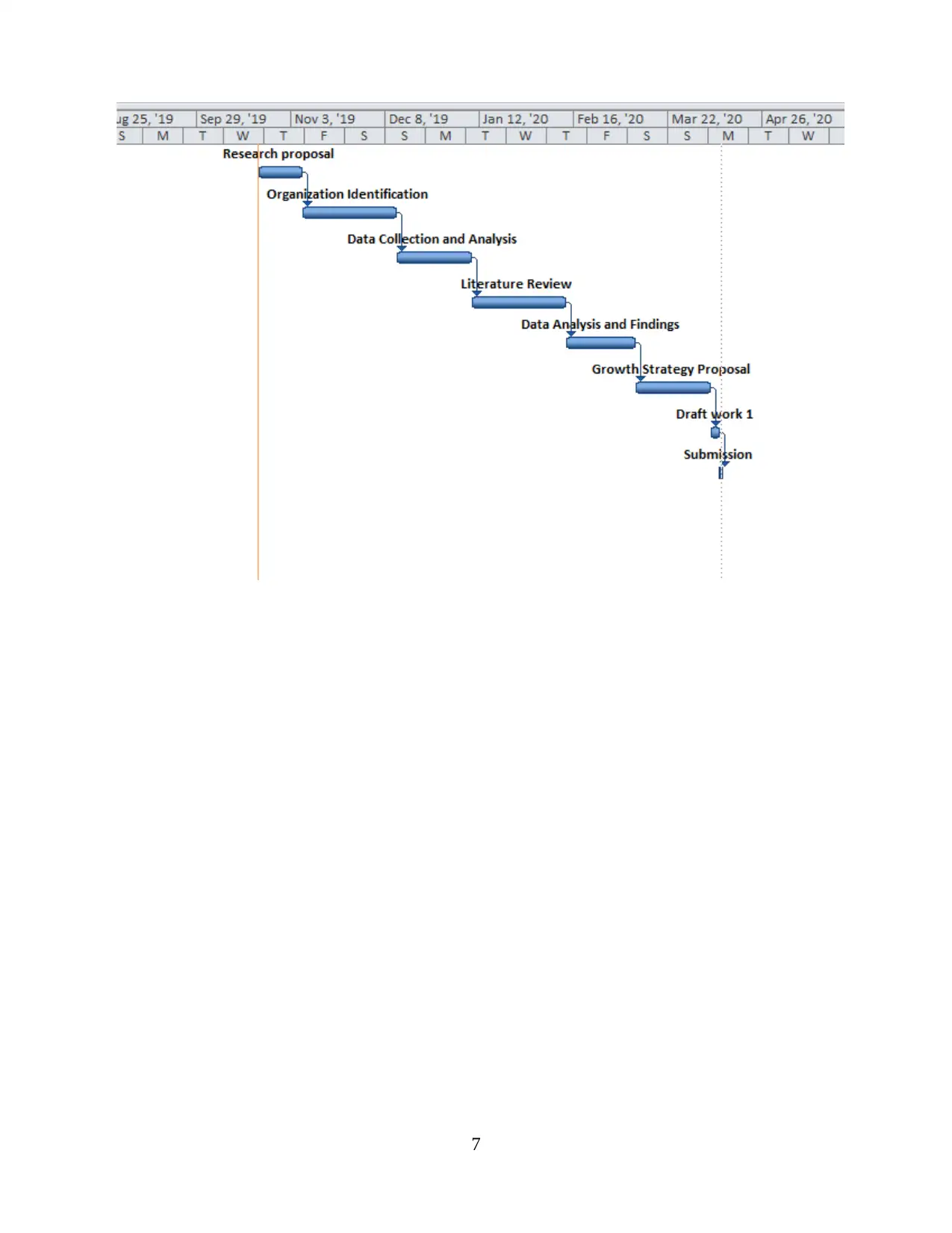
7
⊘ This is a preview!⊘
Do you want full access?
Subscribe today to unlock all pages.

Trusted by 1+ million students worldwide
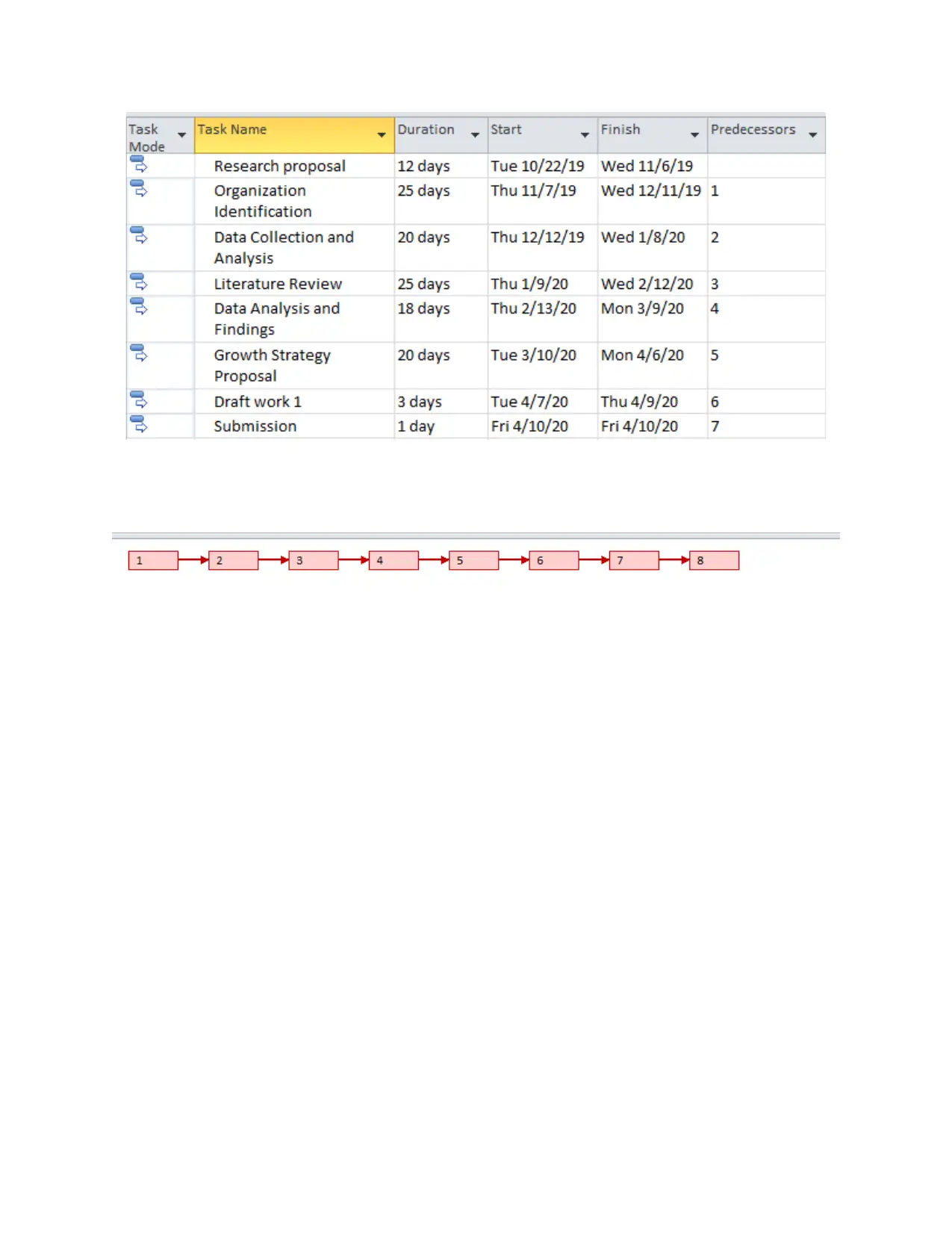
Paraphrase This Document
Need a fresh take? Get an instant paraphrase of this document with our AI Paraphraser
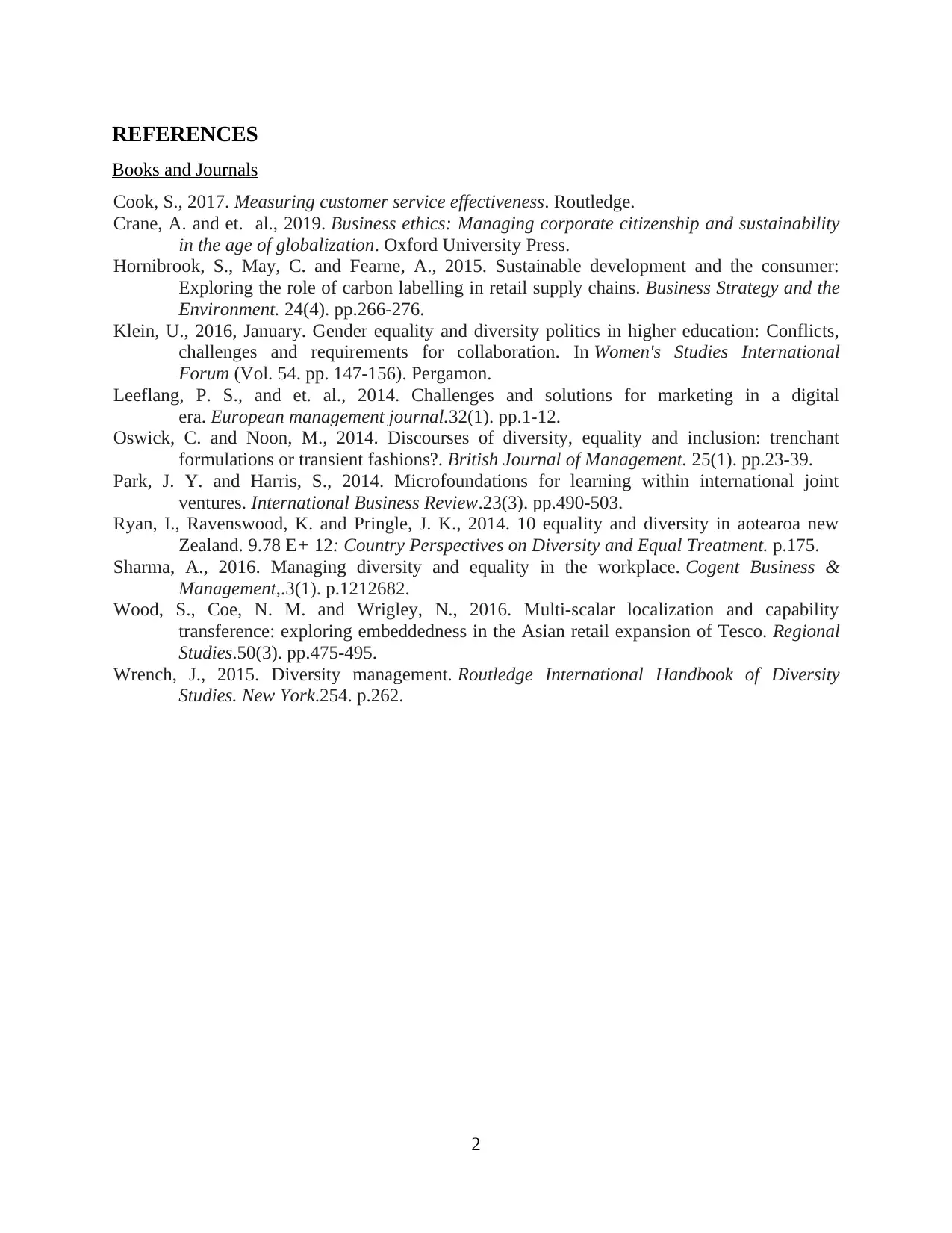
REFERENCES
Books and Journals
Cook, S., 2017. Measuring customer service effectiveness. Routledge.
Crane, A. and et. al., 2019. Business ethics: Managing corporate citizenship and sustainability
in the age of globalization. Oxford University Press.
Hornibrook, S., May, C. and Fearne, A., 2015. Sustainable development and the consumer:
Exploring the role of carbon labelling in retail supply chains. Business Strategy and the
Environment. 24(4). pp.266-276.
Klein, U., 2016, January. Gender equality and diversity politics in higher education: Conflicts,
challenges and requirements for collaboration. In Women's Studies International
Forum (Vol. 54. pp. 147-156). Pergamon.
Leeflang, P. S., and et. al., 2014. Challenges and solutions for marketing in a digital
era. European management journal.32(1). pp.1-12.
Oswick, C. and Noon, M., 2014. Discourses of diversity, equality and inclusion: trenchant
formulations or transient fashions?. British Journal of Management. 25(1). pp.23-39.
Park, J. Y. and Harris, S., 2014. Microfoundations for learning within international joint
ventures. International Business Review.23(3). pp.490-503.
Ryan, I., Ravenswood, K. and Pringle, J. K., 2014. 10 equality and diversity in aotearoa new
Zealand. 9.78 E+ 12: Country Perspectives on Diversity and Equal Treatment. p.175.
Sharma, A., 2016. Managing diversity and equality in the workplace. Cogent Business &
Management,.3(1). p.1212682.
Wood, S., Coe, N. M. and Wrigley, N., 2016. Multi-scalar localization and capability
transference: exploring embeddedness in the Asian retail expansion of Tesco. Regional
Studies.50(3). pp.475-495.
Wrench, J., 2015. Diversity management. Routledge International Handbook of Diversity
Studies. New York.254. p.262.
2
Books and Journals
Cook, S., 2017. Measuring customer service effectiveness. Routledge.
Crane, A. and et. al., 2019. Business ethics: Managing corporate citizenship and sustainability
in the age of globalization. Oxford University Press.
Hornibrook, S., May, C. and Fearne, A., 2015. Sustainable development and the consumer:
Exploring the role of carbon labelling in retail supply chains. Business Strategy and the
Environment. 24(4). pp.266-276.
Klein, U., 2016, January. Gender equality and diversity politics in higher education: Conflicts,
challenges and requirements for collaboration. In Women's Studies International
Forum (Vol. 54. pp. 147-156). Pergamon.
Leeflang, P. S., and et. al., 2014. Challenges and solutions for marketing in a digital
era. European management journal.32(1). pp.1-12.
Oswick, C. and Noon, M., 2014. Discourses of diversity, equality and inclusion: trenchant
formulations or transient fashions?. British Journal of Management. 25(1). pp.23-39.
Park, J. Y. and Harris, S., 2014. Microfoundations for learning within international joint
ventures. International Business Review.23(3). pp.490-503.
Ryan, I., Ravenswood, K. and Pringle, J. K., 2014. 10 equality and diversity in aotearoa new
Zealand. 9.78 E+ 12: Country Perspectives on Diversity and Equal Treatment. p.175.
Sharma, A., 2016. Managing diversity and equality in the workplace. Cogent Business &
Management,.3(1). p.1212682.
Wood, S., Coe, N. M. and Wrigley, N., 2016. Multi-scalar localization and capability
transference: exploring embeddedness in the Asian retail expansion of Tesco. Regional
Studies.50(3). pp.475-495.
Wrench, J., 2015. Diversity management. Routledge International Handbook of Diversity
Studies. New York.254. p.262.
2
1 out of 11
Related Documents
Your All-in-One AI-Powered Toolkit for Academic Success.
+13062052269
info@desklib.com
Available 24*7 on WhatsApp / Email
![[object Object]](/_next/static/media/star-bottom.7253800d.svg)
Unlock your academic potential
Copyright © 2020–2025 A2Z Services. All Rights Reserved. Developed and managed by ZUCOL.





